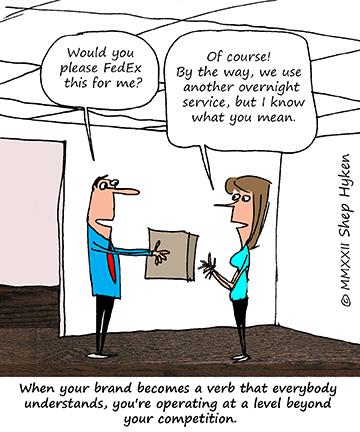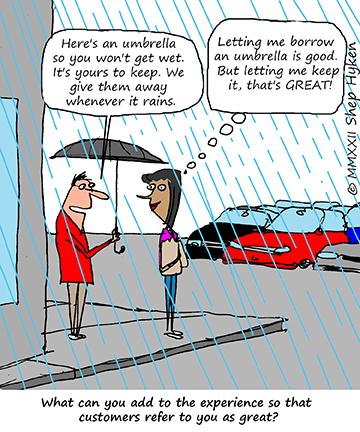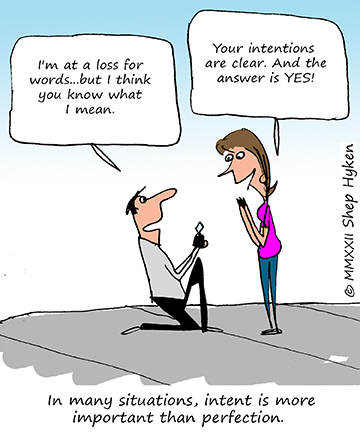Shep Hyken's Blog, page 61
July 11, 2022
5 Top Customer Service Articles of the Week 7-11-2022
Each week I read many customer service and customer experience articles from various resources. Here are my top five picks from last week. I have added my comment about each article and would like to hear what you think too.
3 Ways to Create a Better Customer Experience That Increases Conversions by Joel Comm(Inc. Magazine) As the global marketplace shrinks and communication channels continue to evolve, competition is heating up. Businesses can’t focus on reaching their target audience and call it a day. They also need to win them over — a process that starts and ends with a good customer experience (CX). Here are a few tips to make sure your company is approaching CX in an effective manner that helps you optimize your ability to turn qualified leads into conversions.
My Comment: We start this week’s Top Five Roundup with an article that shares three simple but powerful ideas. A good first impression is a good place to start, and the author shares how to take that first impression to the next level. Then, think about this customer well into the future. Finally, this is an all-the-time consistent effort.
Time to Emphasise Real-Time CX Metrics by Ginger Conlon(Customer Experience Magazine) Developing new approaches to measurement is a priority for businesses that want to drive agile decision making. Journey measurement, for example, can provide insights that allow companies to optimise the customer journey in real time. This will improve the experience and increasing the likelihood of conversions and purchases.
My Comment: How do you measure CX? Let me count the ways! Seriously, to measure CX is one thing. To take action on those insights is another. In other words, It’s essential to understand the “why” behind the metric. That allows you to interpret the data and use it to create a better experience for all customers.
Implement These 5 Customer Experience Analytics to Upgrade Your Call Center by Emily Gregor(Aircall) Data used in customer experience analytics can be drawn from any interaction between an organization and its customers. That includes reviews of your company’s products or services, customer interactions on social media, customer conversations with contact centers, and much more.
My Comment: Here’s another excellent article on CX metrics. This time, the focus is on the customer support center. Here’s a question (and an answer): What metrics should we use to gauge success? The ones that focus on the customer’s satisfaction, not so much the productivity metrics that many support centers use, such as AHT (Average Handle Time). The ones you want are about the customer and include CSAT, NPS, CES, CLV, and more.
Eight Ways to Use Content to Boost Customer Experience by Darwin Jayson Mariano(CX Network) Content marketing is one of the most effective mediums for companies to embrace when they are looking to acquire and retain customers. These savvy firms recognize the importance of developing winning content to create awareness, increase engagement and drive traffic to their business.
My Comment: Content marketing is more than a marketing strategy. It’s part of the customer experience. Are you delivering information that adds value to customers and enhances their experience with your brand? That’s marketing and CX. The beginning of the article references Asian companies. I’m not sure why. Any and every company should consider a content strategy.
The Retention Crisis: Should We Be Treating Employees More Like Customers? by Ivan Harding(TechNative) Businesses are still very much battling retention issues, as talent continues to move between companies at pace. In the last six months alone, one in ten workers said they had quit their jobs, resulting in the highest UK quit rate since 2009
My Comment: Over the years, I’ve shared many articles about culture and “internal customers” (employees and co-workers). Here’s another one that uses the phrase “retention crisis” to describe the severity of the current employment situation. It’s really simple. You want to treat customers in a way that gets them to come back. Do the same with your employees.
[image error]Shep Hyken is a customer service expert, professional speaker, and New York Times bestselling business author. Go to The Customer Focus to learn more about our customer service training programs. Follow on Twitter: @Hyken
to learn more about our customer service training programs. Follow on Twitter: @Hyken
The post 5 Top Customer Service Articles of the Week 7-11-2022 appeared first on Shep Hyken.
July 8, 2022
Guest Post: 6 Customer Service Trends That You’ll Want to Adopt in 2022
This week’s guest post by Sharavanan Shanmugaraju shares six customer service trends that companies need to adopt this year.
Every year, companies find ways to improve customer service. This could be investing in new tools, changing processes, or adding new people to your team against customers. Today we open the main customer service areas in anticipation of 2022. This helps you make better product decisions, increase customer satisfaction and retain more customers overall.
1. AI bots will continue to automate simple support tasksThe role of AI in customer service has grown exponentially in recent years. Every year we witness great achievements. Watson claims that IBM customer service AI robots answer customer questions with 95% accuracy. That’s great. Of course, many companies use bots to automate customer support.
Smart IVR allows you to serve customers directly without going through an agent for support calls. For example, a hospital could use an IVR to allow clients to change appointments over the phone. Hospitals can integrate CRM to monitor patients and appointments. Because the entire process is automated, agents can focus on more important tasks and provide a better customer experience.
But does that mean that robots are replacing human agents? Absolutely not. This allows agents to manage more customers faster and more efficiently.
2. Protecting customer privacy is not optional anymoreWith daily reports of data breaches, today’s consumers are more concerned about the security of their personal information than ever before. Confidentiality is a growing concern of governments and businesses. The EU has taken a major step in the fight against privacy through its GDPR regulation.
Recently, information such as phone numbers and email addresses has become more personalized. Therefore, it is a priority for companies receiving this data to protect and process this information responsibly.
According to Marketing Dive, 71% of consumers are concerned about how brands handle personal data. Companies and government entities have been seen protecting their customers’ contact information by hiding their phone numbers. Many countries, such as Canada, the United Kingdom, and Australia, require consumer consent before sending an email. This is no longer mandatory for consumer privacy organizations. This is crucial for building consumer confidence and a positive overall brand image.
3. Personalisation will be a key differentiatorAs individuals, we all want specially designed experiences. Even the smallest step in the customization process can have amazing results for your brand. Today, banks face stiff competition from leading privatization-based technology companies. However, banks can also offer personal experiences.
Banks can use Smart IVR to provide personalized experiences to registered customers upon request. For example, you can already set the user’s language (depending on your selection). The IVR menu (for registered users) can only read popular options to help users navigate faster.
This may seem like a small improvement, but everything improves the banking experience. The product has many tools to help you create customized experiences on a scale. However, it is a good idea to understand the user’s entire life cycle before you begin.
4. Omni-channel support is critical moving forwardMultichannel support may not be sufficient today. Connecting through these channels is important for a smoother user experience. Omnichannel support is provided here.
Unlike multichannel support, omnichannel combines all channels, such as SMS, calls, social media, and email to serve a single customer without compromising the brand experience. This allows consumers to change channels without repeating questions/problems.
U.S. businesses lose more than $ 62 billion annually because of poor customer service. This clearly shows the need to improve the consumer experience. But no matter what channel you support, creating an experience that is useful and has a lasting impact on users’ minds should always be a priority.
5. Data will empower support agents to make a better and faster decisionEvery company wants to offer a perfect support experience for its customers. It depends on the agent’s job. However, agencies often struggle to meet consumer demands. The main reason is the use of outdated software. It slows you down instead of increasing your productivity.
Giving your agents the right support software can make a big difference. But what can a software support agent do to help? Let’s find out.
It must be seamlessly integrated with all applications to provide real-time customer information. Automate all basic tasks like scheduling callbacks, dialing calls, and running email / SMS. Route the conversation to the appropriate agent based on your past. Automatically solve simple customer questions without contacting an agent. 6. Predictive Analytics will help businesses to stay ahead and provide high-touch CXAccording to the report, the team’s two biggest challenges are cost control and adapting to seasonal peaks. Predictive analytics is an effective way to solve problems. Simply put, predictive analytics is a branch of advanced analytics used to predict the future. Display statistics, machine learning, artificial intelligence, and big data results.
When it comes to supporting, here’s what organizations can achieve using this –
Plan for future peaks and anomalies Pay close attention to customer satisfaction Service quality monitoring Why should companies care?Providing better customer service is vital for companies that offer superior services for which customers are willing to pay more. This can be done by investing in better support tools, a strong communication platform, or hiring the right people for your team.
Sharavanan is the content marketing lead at Exotel. He finds joy in writing about tech by day and poems by night.
 For more articles from Shep Hyken and his guest contributors go to customerserviceblog.com.
For more articles from Shep Hyken and his guest contributors go to customerserviceblog.com.
Read Shep’s latest Forbes article: Customer Experience: A Gift That Can Last Forever
The post Guest Post: 6 Customer Service Trends That You’ll Want to Adopt in 2022 appeared first on Shep Hyken.
July 6, 2022
When Your Company Becomes a Verb
 In our customer service training workshops, we have an exercise that introduces a concept called The Five Levels of Service. The levels advance from Unacceptable to Basic to Good to World Class to Trademark. Any company should be happy with World Class, which is when the company is consistently and predictably delivering a level of service that gets customers to come back. Very few companies can get to Trademark levels of service. This happens when a company or brand is referred to in a way that positions them as one of the best at what they do. Most often, it is a comparison. For example, people might say, “They are the Cadillac of their industry.” Obviously, that is a powerful complement for both the company and for Cadillac.
In our customer service training workshops, we have an exercise that introduces a concept called The Five Levels of Service. The levels advance from Unacceptable to Basic to Good to World Class to Trademark. Any company should be happy with World Class, which is when the company is consistently and predictably delivering a level of service that gets customers to come back. Very few companies can get to Trademark levels of service. This happens when a company or brand is referred to in a way that positions them as one of the best at what they do. Most often, it is a comparison. For example, people might say, “They are the Cadillac of their industry.” Obviously, that is a powerful complement for both the company and for Cadillac.
Along those same lines, I was talking with a client who said, “We want to Chick-fil-A our customers.” Now, Chick-fil-A is a fast-casual restaurant known for its chicken and great customer service, but I’ve never heard of the company name used as a verb. It wasn’t a week later when I heard someone else say almost exactly the same thing. This is an example of Chick-fil-A hitting the Trademark level of service.
It’s quite flattering for a company to be mentioned in this fashion. If you have experienced Chick-fil-A, you know that it is not just the food that brings you back. It has created a service experience that is praised and studied by many other companies and brands. It has a customer-focused culture, hires good people, and is consistent and predictable. That’s part of a winning business strategy that has created a reputation on par with the most iconic brands in the customer service and experience world. And when you hit that level, others want to learn how to have the same success.
A Customer Experience Like Chick-fil-ATo make my point, my friend and fellow customer service expert John DiJulius was contacted by the Charlotte Police Department (CMPD) to help them deliver a customer experience like Chick-fil-A. Yes, the chief of police specifically said that they want to provide a Chick-fil-A level of service. It turns out that 97% of police interactions with the public do not result in an arrest. Of the less than 3% that do, only about half a percent are for violent crimes. In other words, about 97% of the police interactions could potentially be positive customer experiences – even a Chick-fil-A experience.
So, I wonder, how many other brand names like Chick-fil-A are used as verbs or nouns to describe how a company wants to deliver great service? If your brand is used in a sentence to position it as the brand that others should emulate, then you are operating at a Trademark level of service. It’s a lofty goal and one worth pursuing. You may or may not attain it, but along the way, you could still be recognized as a World-Class organization.
Shep Hyken is a customer service expert, keynote speaker, and New York Times, bestselling business author. For information on The Customer Focus customer service training programs, go to www.thecustomerfocus.com. Follow on Twitter: @Hyken
customer service training programs, go to www.thecustomerfocus.com. Follow on Twitter: @Hyken
The post When Your Company Becomes a Verb appeared first on Shep Hyken.
July 5, 2022
Amazing Business Radio: Matthew Holman
 Earning Customers for Life
Earning Customers for Life How to Prevent Your Customers from Shopping Your Competition
Shep Hyken interviews Matthew Holman, head of growth at QPilot, an eCommerce software company that makes subscriptions more flexible for brands and customers. He shares how subscription models can shape the customer experience to meet the changing needs of their customers.






 Top Takeaways:People consume differently and customers’ needs change. Brands should offer flexibility with the frequency of their subscriptions and product options.In the typical subscription experience, customers cancel their subscriptions once their need for the product no longer exists. But what happens when they want to renew their subscription? That can create a huge friction point.Companies that want to offer a subscription service get caught up in how amazing or complex they could make something. Always think of what is available, what you can do now, and scale from there.Businesses always worry about how to make revenue. If they look at things through the lens of a subscription model, create additional engagement, and nurture relationships, they can earn customers – and revenue – for life.With subscriptions, around 80% of your customer base will be fairly standard on how they shop. But the difference between a business staying alive and a losing business is that extra 20% of people that are on the margins. Those are the people that need flexibility.Many people resist the idea of companies having their data, but the goal of any good brand is to create trust, communication, and engagement. Customers will share data with the companies they trust. When the data is used properly, it creates a better experience for the customer.You need to find out what your customers need and want. Talk to your end-users. Test and survey your customers to understand their actual pain points. If you can develop something within your business model that can service that need, you’ll be able to become more profitable and grow revenue.Quotes:
Top Takeaways:People consume differently and customers’ needs change. Brands should offer flexibility with the frequency of their subscriptions and product options.In the typical subscription experience, customers cancel their subscriptions once their need for the product no longer exists. But what happens when they want to renew their subscription? That can create a huge friction point.Companies that want to offer a subscription service get caught up in how amazing or complex they could make something. Always think of what is available, what you can do now, and scale from there.Businesses always worry about how to make revenue. If they look at things through the lens of a subscription model, create additional engagement, and nurture relationships, they can earn customers – and revenue – for life.With subscriptions, around 80% of your customer base will be fairly standard on how they shop. But the difference between a business staying alive and a losing business is that extra 20% of people that are on the margins. Those are the people that need flexibility.Many people resist the idea of companies having their data, but the goal of any good brand is to create trust, communication, and engagement. Customers will share data with the companies they trust. When the data is used properly, it creates a better experience for the customer.You need to find out what your customers need and want. Talk to your end-users. Test and survey your customers to understand their actual pain points. If you can develop something within your business model that can service that need, you’ll be able to become more profitable and grow revenue.Quotes:“The best model for a subscription service is one that has a product that can be consumed regularly and content that provides value to the customers.”
“Find a way to create additional value and engagement to your products. And, if you’re good at it, you can charge extra for it.”
“Create a level of engagement with a subscription model that when your customers run out of your product, you eliminate the need for them to think about where they need to go next.”
“The best type of subscription creates a relationship that keeps customers from shopping around.”
“In a subscription model, if you don’t provide a way for customers to pause their subscription, they will cancel.”
About:Matthew Holman is head of growth at QPilot. He works with brands to scale their subscription programs using data, best practices, and experimentation.
Shep Hyken is a customer service and experience expert, New York Times bestselling author, award-winning keynote speaker, and your host of Amazing Business Radio.
This episode of Amazing Business Radio with Shep Hyken answers the following questions and more:
What is a subscription model?What type of business can be a subscription model?How can brands provide customers with flexibility when it comes to their subscriptions?How can brands with a subscription model increase profit?What does the future of subscription models look like?The post Amazing Business Radio: Matthew Holman appeared first on Shep Hyken.
July 4, 2022
5 Top Customer Service Articles of the Week 7-4-2022
Each week I read many customer service and customer experience articles from various resources. Here are my top five picks from last week. I have added my comment about each article and would like to hear what you think too.
7 Top AI Trends in Customer Service by Zendesk(EnterpriseAI) Ever-evolving technology is constantly changing how customer service is done. From call centers to contact centers, businesses are looking for ways to automate manual tasks and take care of their customers better. Customer support has always been a challenging task for companies to manage, and with the introduction of artificial intelligence (AI) solutions, it’s easier than ever before.
My Comment: We open this week’s Top Five roundup with a list of seven AI (Artificial Intelligence) trends in the customer experience world. This is exactly how AI is being used today. It helps understand the customer better, allows you to personalize (at scale) marketing messages, improve the shopping experience, and more.
4 Strategic Approaches to Customer Journey Mapping by Jennifer Torres(CMSWire) What’s in your abandoned cart? From a tube of mascara to a jade bracelet or water pump, retailers are paying the price for the items left behind. And the price tag? $260 billion in lost revenue over 10 years (in the US and EU) due to preventable cart abandonment, according to the Baymard Institute.
My Comment: Journey Mapping is no longer an option. You must understand the interaction points your customers have with you before, during, and after their buying experience. This is a “how to get started” type of article. Perfect for those that haven’t gone through the journey mapping process.
15 Metrics To Track If You Want To Keep Your Customers Happy And Loyal by Forbes Councils Member(Forbes) Having many returning customers is the goal of most successful businesses. Returning customers not only keep a consistent revenue stream coming in, they also typically refer others to a business’s product or service, too.
My Comment: How do you measure customer happiness and loyalty? Let me count the ways! Actually, 15 of them. Starting with NPS (the likelihood that a customer would recommend you) to response times (how quickly you respond to a customer’s questions, inquiries, etc.), you will find some of the most effective ways to measure your focus on customers.
Easy Does It: Five Keys To Curating An Effortless, Loyalty-Building Customer Experience by Craig Halliday(Newsweek) Whether your company sells home furnishings or software, being easy to do business with means embedding certain customer experience (CX) fundamentals into your organizational DNA. Here are five that have proven important in serving and supporting the customer.
My Comment: Just as the article implies, this is about creating an “easy” experience for your customers. While all five are important, number five, being a partner, is one to pay attention to. The most successful relationships in business are when your customers view you as a partner versus a vendor.
75% of Consumers Say Customer Experience Impacts Brand Loyalty, Merkle Report Finds by PRNewswire(MarTech Series) Loyalty programs are no longer just about discounts and transactions. Consumers want brands to go the extra mile to connect with them, and more than 75 percent of consumers say consistent customer experiences and customer service improve their likelihood to do business with a brand. This shift requires brands to build loyalty across the entire customer experience, in close partnership with forward-thinking experience and commerce agencies, using human design principles.
My Comment: A loyalty program needs to be more than just points and perks. If you want customers to be loyal, you must create an experience that is easy and makes them feel appreciated. Just as the title implies, customers now want more than the points. They want the experience.
BONUSWelcome to Sage Book Club! by Jay Baer(Sage) Jay Baer shares his top six book recommendations to teach you all you need to know about customer experience. His favorite reads will help you on the road to building a resilient business.
My Comment: Fellow customer experience expert, Jay Baer, has put together his list of the top six customer experience books. I won’t argue with any of his choices and am honored and flattered he included The Cult of the Customer as one of his picks. If there was a book to add to the list, I would suggest Jay’s book Talk Triggers.
[image error]Shep Hyken is a customer service expert, professional speaker, and New York Times bestselling business author. Go to The Customer Focus to learn more about our customer service training programs. Follow on Twitter: @Hyken
to learn more about our customer service training programs. Follow on Twitter: @Hyken
The post 5 Top Customer Service Articles of the Week 7-4-2022 appeared first on Shep Hyken.
July 1, 2022
Navigating Airlines Travel Experience with the Metaverse
This week we feature an article by Prabhjinder Bedi, Chief Growth Officer at Tech Mahindra Business Process Services. He writes about the impact on the customer experience that metaverse will have on the travel industry and how customers and brands will navigate the new developments.
Customer service in the travel industry begins when a person reveals an interest to explore and decides to travel. Post the decision phase, the traveler has multiple touchpoints that lead to the actual travel. Here, attention to minute details is a catalyst to fulfilling the entire travel experience.
There are apps for almost everything, especially hotels, restaurants, attractions, and museums. These are accessible to people who seek better information on travel and specific locations. More and more people are learning about different places through these different apps and social media platforms. You can read some reviews about the location and some blog posts.
With the ongoing pandemic, the travel industry is probably the closest to witnessing a hyper-focus on customer experience. In the evolving times, all it takes is a click of a button on social media to make it viral! Whether it is an overwhelming experience or an unforgettable one, it is instantly highlighted with feedback.
Metaverse in Travel IndustryThe metaverse’s notion is that avatars will be platform-agnostic, and we will be able to easily shift our digital assets from one platform to the other. This implies it’s interoperable, allowing users to move about freely like they would in the real world.
So, what influence might this parallel digital universe have on the travel business if it continues to grow? Will individuals abandon travel completely to see global places only through virtual reality? Will life as we know it become a science fiction film? How can you replace the sensation of water droplets showering on your skin, the rush of wind on your face, the scent of dirt when it rains, or the warmth of the sun caressing your face on a cold morning? As you can see, metaverse cannot totally replace travel. It will, however, complement travel and, over time, become an integral element of the travel ecology. It may even alter the way passengers make pre-, post-, and on-trip purchases.
Since the global pandemic hugely impacted the airline sector, the metaverse has become increasingly important. Travel businesses are developing systems that will allow customers to virtually experience hotel rooms and flights, underlining the need to “try before you buy” when it comes to travel. Thanks to the technology, passengers will be able to quickly locate check-in desks, escalators, the correct gate, and baggage claim locations at the airport.
Data-Driven Customer Experience that Offers Personalized ServiceWith thousands of potential routes and fares at their fingertips, airlines have to ask themselves how they can provide relevant information to individual customers. While there is no one-size-fits-all solution for this problem, machine learning (ML) offers a promising way forward. This technique is used by many airlines to analyze data and offer personalized services such as best fare alerts or other extras that might be of interest to travelers.
Ways to Improve Customer Experience in Travel IndustryReadily access and integrate one or more of the following elements into your strategy to improve customer experience (CX) in the travel industry:
ChatBots and AISmart RoomsVirtual RealityAugmented RealityUser-generated contentThe global metaverse in the travel industry has been split into blockchain, augmented reality (AR), and virtual reality (VR) based on technology. Over time, the AR category is likely to account for a considerable revenue share. This is via the growing usage of AR-infused navigation for virtual destination tours, technological breakthroughs in AR-enabled devices, and the use of AR to enhance local transit and museum tours. AR technology may potentially benefit the travel sector by increasing consumers’ hunger and curiosity for new destinations, assisting travel agencies in increasing ticket and hotel booking volume, and improving the overall travel experience.
An efficient CX framework is established with the ability to anticipate customer needs, wants, and/or behaviors and customize the offers, services & communications to that specific need/want/behavior. Additionally, contextualizing the process of putting information, making sense of information from the situation, time, journey, or location in which the information was found, and pleasant interactions are the set feature that is part of the product or service that are useful & easy to use.
Next-generation omnichannel e-commerce marketplace to onboard and manage brand products and services:
A unified Marketplace designed to provide a personalized shopping experience for passengers and non-passengers Optimized marketing effectiveness across engagement points Improved operational efficiency with faster time to market Accelerated conversions while decreasing fallouts Grow revenues & increase sales through upselling & cross-selling Respond swiftly to changing needs & expectations from Brand partners – both content & productAs we know, the metaverse is the digital and physical convergence into a new experience. We believe that several aspects of the airport can be experienced by the passenger virtually and enjoyed too. For example, the traveler can enjoy duty-free shopping and duty-paid goods purchases at the airport in a Virtual world even before they enter the airport. Another example can be the terminal environment in the Metaverse world, where a traveler who doesn’t speak the language or doesn’t travel often can experience the airport terminal in a digital avatar. When ready at a future date – Cryptocurrencies can also be used to complete the shopping experience. The fulfillment of the shopping can be done by delivery at the Aircraft boarding point.
The metaverse shopping experience can be so rich and engaging for travelers that it can also attract significant participation from Retailers. There can be a limitless number of ‘Virtual Concessionaires in the Metaverse’ that GMR Airports can onboard.
Improved Airport Throughput & ProductivityEmphasize the journey-centric perspective of airport operations for seamless customer experience via the metaverse:
Focus on specific areas to improve capacity – such as addressing a single bottleneck to improve throughput. With flight, operational, and engagement data, end-to-end movement data can create detailed behavioral profiles to improve resourcing and smooth customer journey. Passenger forecasting solutions, flow, and density management maximize distancing between passengers with real-time signal processing and virtual queuing. Anticipating when passengers will show up and creating plans that match resource capacity with actual demand while ensuring an all-around high performance at the airport. Providing the right data and giving the insights and recommendations needed to deliver using an AI-based solution that leverages video analytics. From check-in to security to immigration, analyzing situations, proactively action, and efficient movement. Customer Engagement Framework in Tech MahindraAt Tech M, the Customer Engagement Framework is aimed at helping organizations improve their Customer Engagement efforts through 6 quintessential actions:
Understand the customers Optimizing performance Listening to universal behaviors Building marketing content Planning the budget Designing customer experienceAddressing the travel CX program needs will require developing new capabilities across the enterprise’s current state, focused on transactions and not conversations, disconnected with the customer universe and process being the hero. Whereas the target state aims to focus on a shared conversation state across touchpoints in a converging universe where people (employees and passengers) are central to the story – adaptive processes. The only way to achieve this is through an amalgamation of point solutions, with IT and enterprise capabilities.
Prabhjinder Bedi is the Chief Growth Officer at Tech Mahindra Business Process Services. He has over two decades of experience involving launching start-up ecosystems, scaling-up businesses, taking products and services to market, and exposure to industry verticals spanning Telecom and Media, Financial Services, Retail, and Consumer Goods, Manufacturing to Lifesciences.
 For more articles from Shep Hyken and his guest contributors go to customerserviceblog.com.
For more articles from Shep Hyken and his guest contributors go to customerserviceblog.com.
Read Shep’s latest Forbes article: The Top Five Reasons Customers Don’t Come Back
The post Navigating Airlines Travel Experience with the Metaverse appeared first on Shep Hyken.
June 29, 2022
The Difference Between Good and Great
 If you had to have surgery, would you rather go to the most skilled surgeon or the nicest surgeon?
If you had to have surgery, would you rather go to the most skilled surgeon or the nicest surgeon?
I was at a party the other night and someone I met shared his opinion of the difference between a good doctor and a great doctor. A good doctor makes you well. A great doctor makes you well and calls you the next day to see how you’re doing.
I thought about that all weekend. My new friend was saying that good is doing what you are expected to do. If you’re a surgeon, you make people well. However, great is the addition of a better customer experience. In the case of the surgeon, it’s skill plus bedside manner.
Here’s a “less critical” example. If you go to a restaurant that has the most delicious food, but the service is outright terrible, you wouldn’t refer to that as a great experience. The food could be the best, but if what surrounds it – the experience – is tainted with rude and angry employees, you would be reluctant to go back.
So, back to my friend’s example. The doctor’s bedside manner, which included a phone call to check on the patient, is a metaphor for a good customer experience – or in this case, a patient experience.
Sweetwater, an online retailer that sells music and audio equipment, is another excellent example of this. I bought a new microphone and mixing board from them last year, and they assigned a salesperson to my account. A week after I received the items, “my” salesperson called me to make sure they were working and confirm that I was happy with my purchase. A good experience would have been talking to a salesperson, ordering the equipment, and having it show up as expected in a day or two. What elevated it to a great experience was the less-than-one-minute phone call I received from “my guy.”
Creating a great customer experience doesn’t mean going over the top. Occasionally, you have opportunities to do so, but if your typical experience includes a little something extra, like a phone call to check on a customer, you move beyond just being good. Our customer service research found that the top reason customers are most likely to come back is because employees are helpful and friendly.
It is expected that a doctor has skill. If the doctor is also helpful and friendly, another way of saying the doctor has a good bedside manner, then by my friend’s definition, he or she is a great doctor.
So, what’s your version of bedside manner? What little something can you add to the experience so that people will refer to you as great? Don’t answer me. Sit down with your team and answer these questions for yourself and your organization. Define your version of what would make you a great doctor, communicate it to your people, train them to deliver on it, and watch your customers’ reactions. They will reward you by saying, “I’ll be back!”
Shep Hyken is a customer service expert, keynote speaker, and New York Times, bestselling business author. For information on The Customer Focus customer service training programs, go to www.thecustomerfocus.com. Follow on Twitter: @Hyken
customer service training programs, go to www.thecustomerfocus.com. Follow on Twitter: @Hyken
The post The Difference Between Good and Great appeared first on Shep Hyken.
June 28, 2022
Amazing Business Radio: Adam Alfia
 Convenient Customer Feedback In Realtime
Convenient Customer Feedback In RealtimeHow to Use Customer Feedback to Improve Performance
Shep Hyken interviews Adam Alfia, co-founder of Feedback. He has a firmly entrenched background in high-end hospitality and entertainment. He shares how companies can utilize customer feedback to create a great experience.






 Top Takeaways:There is a slow death of customer service. Many younger employees don’t come out of high school or college knowing what they want to do for the rest of their lives, so many don’t have a vested interest in their jobs. As a result, they don’t go above and beyond to build a strong relationship with the customer base in the industry that they work in.Many companies think that since their employees will leave after a short time, they don’t invest in training. This is flawed thinking because anytime you put somebody that’s not prepared on the frontline, they become the face of your brand at the moment. You want all employees on the frontline to be properly trained.A good training program becomes even more important in an economy where it is difficult to hire and keep good employees.The generation that grew up behind cell phones may be very vocal on social media, but most of them are unwilling to provide face-to-face feedback. Train your employees to be observant of body language and to respond to your customers’ non-verbal cues.There’s an antagonistic relationship that Yelp has created between businesses and customers. Sometimes, customers go to Yelp as a form of revenge when they have had a bad experience, attempting to make the company look bad in front of everyone.Make it easy for customers to give feedback, especially negative feedback. If you make it hard for them to leave a comment, they could go to the next option, which is to broadcast it to everybody and hope to get a response from the business.Customer service is a team sport. Technology, like Realtime Feedback, can help you work with your customers to create the best experience for them.Quotes:
Top Takeaways:There is a slow death of customer service. Many younger employees don’t come out of high school or college knowing what they want to do for the rest of their lives, so many don’t have a vested interest in their jobs. As a result, they don’t go above and beyond to build a strong relationship with the customer base in the industry that they work in.Many companies think that since their employees will leave after a short time, they don’t invest in training. This is flawed thinking because anytime you put somebody that’s not prepared on the frontline, they become the face of your brand at the moment. You want all employees on the frontline to be properly trained.A good training program becomes even more important in an economy where it is difficult to hire and keep good employees.The generation that grew up behind cell phones may be very vocal on social media, but most of them are unwilling to provide face-to-face feedback. Train your employees to be observant of body language and to respond to your customers’ non-verbal cues.There’s an antagonistic relationship that Yelp has created between businesses and customers. Sometimes, customers go to Yelp as a form of revenge when they have had a bad experience, attempting to make the company look bad in front of everyone.Make it easy for customers to give feedback, especially negative feedback. If you make it hard for them to leave a comment, they could go to the next option, which is to broadcast it to everybody and hope to get a response from the business.Customer service is a team sport. Technology, like Realtime Feedback, can help you work with your customers to create the best experience for them.Quotes:“Customer relationship is a byproduct of the brand and the employees’ vested interest in taking care of the customer.”
“Customers are much more willing to give you their feedback digitally than in person.”
“When customers go on social media to share their negative experiences, it is because you didn’t give them what they wanted when they asked for it the first time, whether in person, by email, or via a phone call to customer support.”
“Customers love helping businesses that they patronize. Use your customers as your eyes and ears. Customer feedback should be where customers can let you know what they need.”
“If you’re not using the information your customers share within your surveys to drive change, you’re just creating the illusion that you care.”
“Don’t wait for customers to give you feedback. Ask your customers to provide feedback in the middle of the experience. You’ll learn more about them than you think.”
About:Adam Alfia is the co-founder of Feedback, a digital solution for getting real-time feedback from customers.
Shep Hyken is a customer service and experience expert, New York Times bestselling author, award-winning keynote speaker, and your host of Amazing Business Radio.
This episode of Amazing Business Radio with Shep Hyken answers the following questions and more:
What is real-time feedback?Why is customer feedback so important?How does customer feedback improve performance?How do you collect feedback from customers?What is the best way to capture feedback?The post Amazing Business Radio: Adam Alfia appeared first on Shep Hyken.
June 27, 2022
5 Top Customer Service Articles of the Week 6-27-2022
Each week I read many customer service and customer experience articles from various resources. Here are my top five picks from last week. I have added my comment about each article and would like to hear what you think too.
How to Create an Inviting Customer Experience by Andie Burjek(CMSWire) Even in a complex, digital brand environment, customers expect a seamless customer experience (CX). People want to feel like they can find information or contact a representative without going through too many hoops. They want short wait times, helpful responses and easy navigation through whatever channel they choose to find information. The smoother the customer experience, the more positive they will feel about whatever issue or question they have.
My Comment: We open this week’s Top Five Roundup with some reminders about what it takes to create that “inviting experience.” We want our customers to feel appreciated and welcomed. While all the tips here are good, I’m drawn to number five, which is to remember that the key to a good customer experience is an employee experience.
You Can’t Measure Happiness, but You Can Measure Success – Financial Metrics for Customer Loyalty Strategies by Kobie Marketing, Tata Consultancy Services, Vesta(Loyalty360) Acquiring internal support for customer loyalty programs and strategies can be a challenge for any brand. When it comes to adding new technology, functionality, or program benefits, marketers must work across brand teams to secure buy-in and support to ensure success. However, customer loyalty-focused marketers may have difficulty obtaining support without the right metrics and KPIs, especially from their finance teams.
My Comment: Actually, you can measure happiness. Just watch your customers. Do they come back? Do they refer business to you? I digress. This article is about how to measure the return on your investment in creating customer loyalty. When it comes to spending money on a loyalty program, technology, training, etc., the only way you’ll sell it to the C-Suite is if you can prove ROI.
6 Customer Service Experience Trends to Watch in 2022 by Franck Louveau(EHL Insights) As customer expectations continue to evolve, customer service trends are adapting at pace. Businesses from all industries must keep up with emerging customer service experience trends to meet customer expectations and foster better customer relationships which is critical for remaining competitive in the respective market.
My Comment: It’s never too late to make annual predictions. Here we are, halfway through the year, and an article comes out about six CX trends to watch in 2022. Pay close attention to the first trend, which is to be more proactive than reactive. If you want to prove value to your customers, help them before they know they need help, and fix problems before they know there are problems.
Top Tips to Improve Customer Loyalty by Daniel Hall(BBN Times) Here is a very short article – about a two minute read – with six reminders about what it takes to create loyalty. Customers like a personalized experience. Gathering the right data helps with delivering messaging that appears to be personalized. Data also helps you anticipate what customers want.
My Comment: Here is a very short article – about a two-minute read – with six reminders about what it takes to create loyalty. Customers like a personalized experience. Gathering the right data helps with delivering messaging that appears to be personalized. Data also helps you anticipate what customers want.
Global Report: 45% of People Have Not Felt True Happiness for More Than Two Years by Kimberly Guillon(Oracle) The Happiness Report includes insights from more than 12,000 consumers and business leaders across 14 countries and found that people are searching for new experiences to make them smile and laugh and will reward brands that embrace humor with loyalty, advocacy, and repeat purchases, and walk away from those that don’t.
My Comment: While the title of this article may seem sad, here are two stats that will make you smile: 91% of people prefer brands to be funny and 72% would choose a brand that uses humor over the competition. This comes from a Global Report that surveyed over 12,000 consumers including more than 3,000 business leaders in marketing, sales, and customer service. Humor is important. Make people laugh and smile and they are more likely to do business with you as a customer and stick around as an employee.
[image error]Shep Hyken is a customer service expert, professional speaker, and New York Times bestselling business author. Go to The Customer Focus to learn more about our customer service training programs. Follow on Twitter: @Hyken
to learn more about our customer service training programs. Follow on Twitter: @Hyken
The post 5 Top Customer Service Articles of the Week 6-27-2022 appeared first on Shep Hyken.
June 22, 2022
Good Intentions Can Be More Important Than Perfection
 Not long ago, I wrote about calling your customer or an employee “honey.” It generated dozens of comments. One of our subscribers made a good point.
Not long ago, I wrote about calling your customer or an employee “honey.” It generated dozens of comments. One of our subscribers made a good point.
He agreed that the lesson is about being “socially correct,” but perhaps we should look beyond the name that is used and instead consider the intent of the person using it. He was saying that the server may have intended to create a warm and friendly atmosphere, and calling a person “honey” was her way of doing it. There was no intent to offend or harm. In fact, there was only the intent to serve. As a society, we may be focusing on the wrong thing. What was this server’s goal? It wasn’t to disrespect, belittle or embarrass the customer. She was just being friendly.
However, if you upset a customer by referring to them the wrong way or say something that is socially or politically incorrect, having the best intentions doesn’t make it right. But for training purposes, you have to acknowledge the intent before focusing on the change of behavior.
This brings us to something similar to the “honey lesson” comment in that it ties into intentions.
A friend mentioned that it surprises him when people communicate with poor use of language, and he shared a story that made me smile. Before going further, I realize I’m heading down a dangerous path, as my use of the English language is not perfect. Regardless, I hope you appreciate this story.
As a young man, my friend was the manager of a high-end retail jewelry store. He hired a salesperson, Lila, who, in his words, “Lived only to provide excellent customer service.” As part of the sales process, the salesperson had to get the customer’s information. One afternoon he overheard Lila asking her happy customer, “Where do you live at?” (Yes, this is bad grammar – and I’m guilty of this one, too!)
After the customer left, he politely suggested to Lila that she not end her sentence with a preposition. She said she understood, and that was that. A few days later, he heard her ask the question, “Where do you live at, sir?”
At times, we’ve all been fixated on the wrong things. The correct use of a preposition? Really? I get it. I’m in the communications world, and good grammar is essential. And there are times when people, including me, make mistakes. Many are tolerable and can be fixed quickly with the right attitude and an apology. But remember the lesson here. In many situations, if not most, intent is more important than perfection.
Shep Hyken is a customer service expert, keynote speaker, and New York Times, bestselling business author. For information on The Customer Focus customer service training programs, go to www.thecustomerfocus.com. Follow on Twitter: @Hyken
customer service training programs, go to www.thecustomerfocus.com. Follow on Twitter: @Hyken
The post Good Intentions Can Be More Important Than Perfection appeared first on Shep Hyken.



